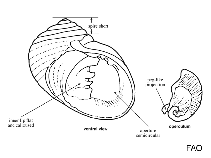Neritodryas dubia (Gmelin, 1791)
Dubious nerite
Envoyez vos Photos
Images Google | No image available for this species;
drawing shows typical species in Neritidae.
Images Google | No image available for this species;
drawing shows typical species in Neritidae.
Classification / Names Common names | Synonyms | CoL | ITIS | WoRMS
| Cycloneritida | Neritidae
Environment: milieu / climate zone / depth range / distribution range Écologie
; saumâtre. Tropical
Distribution Pays | Zones FAO | Écosystèmes | Occurrences | Introductions
Western Pacific: Japan and Philippines.
Length at first maturity / Taille / Poids / Âge
Maturity: Lm ? range ? - ? cm Max length : 2.5 cm ShL mâle / non sexé; (Ref. 821)
Length based on occurrence data; to be replaced with better reference.
Life cycle and mating behavior Maturité | Reproduction | Frai | Œufs | Fécondité | Larves
Members of the order Neritopsina are mostly gonochoric and broadcast spawners. Life cycle: Embryos develop into planktonic trocophore larvae and later into juvenile veligers before becoming fully grown adults.
Référence principale
Références | Coordinateur | Collaborateurs
Springsteen, F.J. and F.M. Leobrera. 1986. (Ref. 821)
Statut dans la liste rouge de l'IUCN (Ref. 130435)
statut CITES (Ref. 108899)
Not Evaluated
CMS (Ref. 116361)
Not Evaluated
Menace pour l'homme
Utilisations par l'homme
| FishSource |
Outils
Plus d'informations
Pays
Zones FAO
Écosystèmes
Occurrences
Introductions
Stocks
Écologie
Régime alimentaire
Éléments du régime alimentaire
Zones FAO
Écosystèmes
Occurrences
Introductions
Stocks
Écologie
Régime alimentaire
Éléments du régime alimentaire
Sources Internet
BHL | BOLD Systems | CISTI | DiscoverLife | FAO(Publication : search) | Fishipedia | GenBank (genome, nucleotide) | GloBI | Gomexsi | Google Books | Google Scholar | Google | PubMed | Arbre de Vie | Wikipedia (Go, chercher) | Zoological Record



